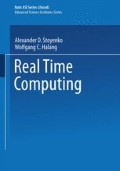Abstract
The Protob methodology integrates several innovative features which have a strong impact on the software life cycle.
It can be applied to discrete event dynamic systems in general, such as real-time embedded systems, distributed systems, communication protocols and manufacturing control systems.
Protob exploits the object oriented paradigm throughout the software life cycle, including the feasibility study and the specification phase, while current specification techniques are based on functional decomposition. The internal dynamic behavior of objects is graphically defined by Prot nets, a formalism which integrates extended dataflows and Petri nets. Prot nets are executable: they enable the model dynamical analysis by means of simulation and rapid prototyping. They visually capture concurrency and synchronization in graphical if-then rules.
Operational, object oriented specifications are easy to understand and reuse. The specification model may be decomposed in components which may be studied and defined by several teams working in parallel. Problem knowledge may be formalized in models and passed on to others to form a library of building blocks.
The Protob methodology also covers the design, implementation and maintenance phases. Its formalism integrates high-level programming languages to form a model of the implementation software. The entire implementation code can be generated automatically.
Access this chapter
Tax calculation will be finalised at checkout
Purchases are for personal use only
Preview
Unable to display preview. Download preview PDF.
References
P. Zave, The operational versus the conventional approach to software development, Communications of the ACM, February 1984, 104–118.
R. Balzer, T. E. Cheatham, and C. Green, Software technology in the 1990’s: using a new paradigm, IEEE Computer, November 1983, 39–45.
G.S. Fishman, Concepts and Methods in Discrete Event Digital Simulation, John Wiley and Sons, 1973.
T. De Marco, Structured analysis and system specification, Prentice-Hall, 1979.
C. Cane and T. Sarson, Structured systems analysis: tools and techniques, Improved System Technology, 1979.
D. T. Ross, Structured analysis (SA): a language for communicating ideas, IEEE Transactions on Software Engineering, January 1977, 16–34.
D. Hatley and I. Pirbhai, Strategies for Real-Time System Specification. Dorset House Publishing, 1987.
P.T. Ward and S.J. Mellor, Structured Development of Real-Time Systems, Yourdon Press, 1985.
W. Bruyn, R. Jensen, D. Keskar, and P. Ward, ESML: an extended systems modelling language based on the data flow diagram, ACM SIGSOFT Software Engineering Notes, Vol. 13, 58–67.
D. Harel, Statecharts: A visual formalism for complex systems, Sci. Comput. Prog., Vol. 8, 1987.
R.H. Wallace, J.E. Stockemberg, and R.N. Charette, A Unified Methodology for Developing Systems, Intertext Publications Inc., 1987.
R. Blumofe and A. Hecht, Executing real-time structured analysis specifications, ACM SIGSOFT Software Engineering Notes, Vol. 13, 1988, 32–40.
D. Harel et al, Statematel: a working environment for the development of complex reactive systems, Proceedings of the Tenth International Conference on Software Engineering, IEEE Press, 1988.
J. Peterson, Petri nets, ACM Computing Surveys, Vol. 9, September 1977, 223–253.
T. Murata, Petri nets: Properties, analysis and applications, Proceedings of IEEE, Vol. 77, April 1989.
K. Jensen, Coloured Petri nets and the invariant method, Theoretical Comput. Sci., Vol. 114, 1981, 317–336.
W. Reisig, Petri nets for software engineering, Petri Nets: Applications and Relations to Other Models of Concurrency, 1986, 63–96.
R.A. Nelson, L.M. Haibt, and P.B. Sheridan, Casting petri nets into programs, IEEE Transactions on Software Engineering, September 1983, 590–602.
G. Bruno and A. Balsamo, Petri net-based object-oriented modeling of distributed systems, ACM Conference on Object-oriented Programming, October 1986, 284–293.
G. Booth, Object oriented development, IEEE Transactions on Software Engineering, Vol. 12, February 1986.
G. Booth, Software Engineering with Ada, Benjamin/Cummings, California, 1987.
R. J. A. Buhr, System Design with Ada, Prentice Hall, Englewood Cliffs, 1984.
M. Heitz, HOOD: Hierarchical Object Oriented Design for development of large technical and realtime software, Technical report, CISI Ingenierie, Direction Midi Pyrenees, 1987.
HOOD Working Group, Hood reference manual, issue 3.0, Technical report, September 1989.
R.J.A. Buhr, G.M. Karam, C.J. Hayes, and C.M. Woodside, Software CAD: a revolutionary approach, IEEE Transactions on Software Engineering, Vol. 15, March 1989.
A. Wasserman, An object oriented structured design method for code generation, ACM SIGSOFT Software Engineering Notes, Vol. 14, January 1989.
P. Coad and E. Yourdan, Object-Oriented Analysis, Prentice Hall, Englewood Cliffs, 1990.
S. Shlaer and S. J. Mellor, Object oriented systems analysis: modelling the world in data, Prentice-Hall, 1988.
J. Rumbaugh, Relations as semantic constructs in an object-oriented language, OOPSLA ‘87 Proceedings, 1987, 466–481.
B. Cohen, W.T. Harwood, and M.I. Jackson, The Specification of Complex Systems, Addison-Wesley, 1986.
A. M. Davis, A comparison of techniques for the specification of external system behavior, Communications of the ACM, Vol 31, No. 9, September 1988, 1098–1115.
G. Bruno and G. Marchetto, Process-translatable Petri nets for the rapid proto-typing of process control systems, IEEE Transactions on Software Engineering, February 1986, 346–357.
M. Baldassari and G. Bruno, An environment for object-oriented conceptual programming based on prot nets, Advances in Petri Nets, Lecture Notes in Computer Science Vol. 340, Springer-Verlag, 1988, 1–19.
M. Baldassari and G. Bruno, An environment for operational software engineering in Ada, Proceedings of the TRI-ADA’89 Conference, October 1989, 126–146.
IEEE Computer special issue on visual programming,August 1985.
R.S. Chin and S.T. Chanson, Distributed object-based programming systems, ACM Computing Surveys, Vol. 23, March 1991.
M. Baldassari and G. Bruno, PROTOB: an object oriented methodology for developing discrete event dynamic systems, Comp. Lang., Vol. 16, January 1991, 39–63.
M. Baldassari and G. Bruno, A methodology and environment for the object oriented analysis and design of real time systems, EUROMICRO’90 workshop on real time, 1990, 72–78.
Author information
Authors and Affiliations
Editor information
Editors and Affiliations
Rights and permissions
Copyright information
© 1994 Springer-Verlag Berlin Heidelberg
About this paper
Cite this paper
Bruno, G., Castella, A. (1994). Requirements Engineering and Design Tools for Real-Time Systems: the Protob Approach. In: Halang, W.A., Stoyenko, A.D. (eds) Real Time Computing. NATO ASI Series, vol 127. Springer, Berlin, Heidelberg. https://doi.org/10.1007/978-3-642-88049-0_22
Download citation
DOI: https://doi.org/10.1007/978-3-642-88049-0_22
Publisher Name: Springer, Berlin, Heidelberg
Print ISBN: 978-3-642-88051-3
Online ISBN: 978-3-642-88049-0
eBook Packages: Springer Book Archive

